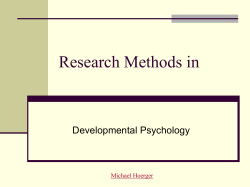
Signs of Depression in Children and Adolescents By John E. Desrochers & Gail Houck
Signs of Depression in Children and Adolescents By John E. Desrochers & Gail Houck Adults, children, and adolescents with depression usually share the common feelings of sadness and hopelessness, but children may express depression in a number of ways that are not the same as adults—irritability and vague physical complaints (e.g., recurrent stomach aches) are classic examples. Other signs that a child might be experiencing depression are listed below. SOCIAL–EMOTIONAL–BEHAVIORAL SIGNS PHYSICAL SIGNS OF DEPRESSION IN OF DEPRESSION IN CHILDREN AND CHILDREN AND ADOLESCENTS ADOLESCENTS Changes in sleep patterns: Difficulty falling Disengagement from friends, family, teachers; asleep or staying asleep; sleeping much more seeking solitude; difficulty with interpersonal than is typical for the child’s age. relationships. Unusually low energy; fatigue; sluggishness in Excessive time alone with videogames and moving, talking, reacting; reduced amount of other solo activities. activity or playing. Reduced participation in previously enjoyed Restlessness and agitation: increased fidgeting, activities; dropping sports and clubs. squirming; reduced ability to sit still. Classroom misbehavior; lack of cooperation. Changes in eating patterns: increased or Decreased performance in school. decreased appetite; weight gain or loss. Tardiness and absence from school. Frequent physical complaints: complaints about Running away or talking about running away. illness symptoms, especially vague ones such as Suicidal talk or attempts; reckless behavior; headaches, stomachaches, muscle aches, and self‐injurious behavior. tiredness. Alcohol and/or drug abuse. Lack of grooming and self‐care. Decreased ability to appropriately cope with COGNITIVE SIGNS OF DEPRESSION IN social events, extracurricular activities, CHILDREN AND ADOLESCENTS hobbies, and family events. Poor attention and concentration. Decreased ability to cope with responsibilities. Poor memory. In young children: regression, clinginess, Difficulty taking tasks to completion. avoidance of new situations, accident Difficulty making decisions. proneness, and fears. Pessimistic world‐view; perceiving things as Increased sensitivity to failure, rejection, and worse than they are; negative attributions. criticism. Negative view of self, life, world, and future. Increased irritability, anger, brooding, or Helplessness and hopelessness; belief that there hostility. is nothing that can be done about their Increased dependency and insecurity. depression and that this is the way it always Apathy and boredom. will be. Feelings of sadness, isolation, hopelessness, Low self‐esteem; over focus on one’s worthlessness, or guilt. deficiencies and failures. Crying or verbal outbursts without apparent Thoughts of suicidal or death; self‐destructive cause. thoughts. Remember that not every child or adolescent who exhibits these signs is depressed; nor do those who are depressed exhibit all these signs. Judging whether a young person is depressed is sometimes very difficult to do. Consulting with a school psychologist, school social worker, school counselor, or school nurse is a good first step for teachers or parents who have concerns. Such a professional will be able to advise you as to whether further assessment or intervention might be warranted. Depression in Children and Adolescents: Guidelines for School Practice, Handout G
© Copyright 2025





















